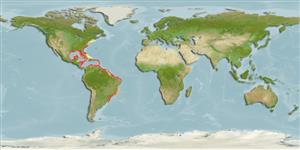>
Eupercaria/misc (Various families in series Eupercaria) >
Lutjanidae (Snappers) > Lutjaninae
Etymology: Rhomboplites: Greek, rhombos = paralelogram + Greek, hoplon, hoplites = with a shield (Ref. 45335).
More on author: Cuvier.
Environment: milieu / climate zone / depth range / distribution range
Οικολογία
Θαλασσινό(ά) βενθικό(ς); εύρος βάθους 40 - 300 m (Ref. 9626), usually 40 - 100 m (Ref. 9626). Subtropical; 42°N - 33°S, 99°W - 30°W (Ref. 55)
Western Atlantic: Bermuda and North Carolina, USA, to São Paulo, Brazil (Ref. 57756), including West Indies, Gulf of Mexico and Caribbean Sea (Anderson, pers. comm.).
Length at first maturity / Μέγεθος / Βάρος / Age
Maturity: Lm 18.8, range 15 - 23 cm
Max length : 60.0 cm TL αρσενικό/απροσδιόριστο; (Ref. 26938); common length : 35.0 cm TL αρσενικό/απροσδιόριστο; (Ref. 55); μεγ. δημοσιευμένο βάρος: 3.2 kg (Ref. 40637); μεγ. αναφερόμενη ηλικία: 10 έτη (Ref. 3090)
Ραχιαίες άκανθες (συνολικά) : 12 - 13; Μαλακές ραχιαίες ακτίνες (συνολικά) : 10 - 11; Εδρικές άκανθες: 3; Μαλακές εδρικές ακτίνες: 8. Snout short, lower jaw slightly projecting. Mouth small. Pectoral fins relatively short, not reaching level of anus. Scale rows on back rising obliquely above lateral line. Back and upper sides vermilion, shading to silvery with reddish tinge ventrally, with narrow horizontal yellow lines below the lateral line. The dorsal and caudal fins yellowish; the anal and pelvic fins whitish.
Adults are found in moderately deep waters, most common over rock, gravel or sand bottoms near the edge of the continental and island shelves, often in large schools. Young fish occur in shallower depths (below 25 m), also often forming large schools. They feed on fishes, shrimps, crabs, polychaetes, other benthic invertebrates, cephalopods and planktonic organisms. Good food fish (Ref. 9626).
Spawning occurs over most of the year with peak activity during spring and summer, at least in the northern part of the range (Puerto Rico to the Carolinas).
Allen, G.R., 1985. FAO Species Catalogue. Vol. 6. Snappers of the world. An annotated and illustrated catalogue of lutjanid species known to date. FAO Fish. Synop. 125(6):208 p. Rome: FAO. (Ref. 55)
IUCN Red List Status (Ref. 130435)
Threat to humans
Harmless
Human uses
αλιεία: περιορισμένης εμπορικότητας
Εργαλεία
Special reports
Download XML
Διαδικτυακές πηγές
Estimates based on models
Preferred temperature (Ref.
123201): 18.3 - 27.2, mean 23.9 °C (based on 185 cells).
Phylogenetic diversity index (Ref.
82804): PD
50 = 1.0000 [Uniqueness, from 0.5 = low to 2.0 = high].
Bayesian length-weight: a=0.01514 (0.01333 - 0.01719), b=2.96 (2.93 - 2.99), in cm total length, based on LWR estimates for this species (Ref.
93245).
Τροφικό Επίπεδο (Ref.
69278): 4.4 ±0.2 se; based on diet studies.
Generation time: 12.2 ( na - na) years. Estimated as median ln(3)/K based on 2
growth studies.
Ελαστικότητα (Ref.
120179): Μεσαίο(α), ελάχιστος χρόνος για διπλασιασμό πληθυσμού 1,4 - 4,4 έτη (K=0.20; tm=3; tmax=10).
Prior r = 0.43, 95% CL = 0.28 - 0.64, Based on 3 full stock assessments.
Fishing Vulnerability (Ref.
59153): Moderate to high vulnerability (50 of 100).
Climate Vulnerability (Ref.
125649): High to very high vulnerability (74 of 100).
Nutrients (Ref.
124155): Calcium = 57.3 [19.9, 118.3] mg/100g; Iron = 0.974 [0.512, 1.815] mg/100g; Protein = 18.9 [17.1, 20.6] %; Omega3 = 0.408 [0.255, 0.664] g/100g; Selenium = 33.1 [17.3, 65.9] μg/100g; VitaminA = 21.1 [6.4, 83.8] μg/100g; Zinc = 0.526 [0.349, 0.788] mg/100g (wet weight);
